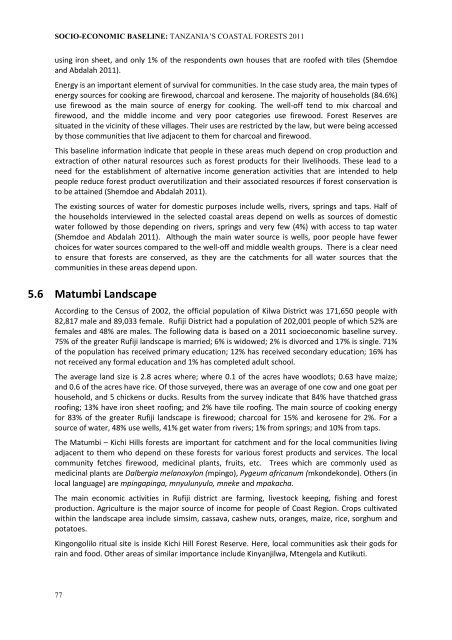Neil D. Burgess, Paul Harrison, Peter Sumbi, James Laizer, Adam ...
Neil D. Burgess, Paul Harrison, Peter Sumbi, James Laizer, Adam ...
Neil D. Burgess, Paul Harrison, Peter Sumbi, James Laizer, Adam ...
You also want an ePaper? Increase the reach of your titles
YUMPU automatically turns print PDFs into web optimized ePapers that Google loves.
SOCIO-ECONOMIC BASELINE: TANZANIA’S COASTAL FORESTS 2011<br />
using iron sheet, and only 1% of the respondents own houses that are roofed with tiles (Shemdoe<br />
and Abdalah 2011).<br />
Energy is an important element of survival for communities. In the case study area, the main types of<br />
energy sources for cooking are firewood, charcoal and kerosene. The majority of households (84.6%)<br />
use firewood as the main source of energy for cooking. The well-off tend to mix charcoal and<br />
firewood, and the middle income and very poor categories use firewood. Forest Reserves are<br />
situated in the vicinity of these villages. Their uses are restricted by the law, but were being accessed<br />
by those communities that live adjacent to them for charcoal and firewood.<br />
This baseline information indicate that people in these areas much depend on crop production and<br />
extraction of other natural resources such as forest products for their livelihoods. These lead to a<br />
need for the establishment of alternative income generation activities that are intended to help<br />
people reduce forest product overutilization and their associated resources if forest conservation is<br />
to be attained (Shemdoe and Abdalah 2011).<br />
The existing sources of water for domestic purposes include wells, rivers, springs and taps. Half of<br />
the households interviewed in the selected coastal areas depend on wells as sources of domestic<br />
water followed by those depending on rivers, springs and very few (4%) with access to tap water<br />
(Shemdoe and Abdalah 2011). Although the main water source is wells, poor people have fewer<br />
choices for water sources compared to the well-off and middle wealth groups. There is a clear need<br />
to ensure that forests are conserved, as they are the catchments for all water sources that the<br />
communities in these areas depend upon.<br />
5.6 Matumbi Landscape<br />
According to the Census of 2002, the official population of Kilwa District was 171,650 people with<br />
82,817 male and 89,033 female. Rufiji District had a population of 202,001 people of which 52% are<br />
females and 48% are males. The following data is based on a 2011 socioeconomic baseline survey.<br />
75% of the greater Rufiji landscape is married; 6% is widowed; 2% is divorced and 17% is single. 71%<br />
of the population has received primary education; 12% has received secondary education; 16% has<br />
not received any formal education and 1% has completed adult school.<br />
The average land size is 2.8 acres where; where 0.1 of the acres have woodlots; 0.63 have maize;<br />
and 0.6 of the acres have rice. Of those surveyed, there was an average of one cow and one goat per<br />
household, and 5 chickens or ducks. Results from the survey indicate that 84% have thatched grass<br />
roofing; 13% have iron sheet roofing; and 2% have tile roofing. The main source of cooking energy<br />
for 83% of the greater Rufiji landscape is firewood; charcoal for 15% and kerosene for 2%. For a<br />
source of water, 48% use wells, 41% get water from rivers; 1% from springs; and 10% from taps.<br />
The Matumbi – Kichi Hills forests are important for catchment and for the local communities living<br />
adjacent to them who depend on these forests for various forest products and services. The local<br />
community fetches firewood, medicinal plants, fruits, etc. Trees which are commonly used as<br />
medicinal plants are Dalbergia melanoxylon (mpingo), Pygeum africanum (mkondekonde). Others (in<br />
local language) are mpingapinga, mnyulunyulo, mneke and mpakacha.<br />
The main economic activities in Rufiji district are farming, livestock keeping, fishing and forest<br />
production. Agriculture is the major source of income for people of Coast Region. Crops cultivated<br />
within the landscape area include simsim, cassava, cashew nuts, oranges, maize, rice, sorghum and<br />
potatoes.<br />
Kingongolilo ritual site is inside Kichi Hill Forest Reserve. Here, local communities ask their gods for<br />
rain and food. Other areas of similar importance include Kinyanjilwa, Mtengela and Kutikuti.<br />
77

















